Curry leaf plant bunnings are one of the most healthy spices to use in your cuisines. But, growing them can be a little complex process as the plants and the tree have totally different requirements, especially sunlight.
With ample knowledge about the plants, you can easily grow them indoors and outdoors. In this article, we will be discussing the specifications, benefits, growing tips, caring for the plant, and management of diseases/pests. Let’s get started!
Contents
An Insight Into Curry Leaf Tree
The curry leaf also known by the name “Murraya koenigii” can be labeled as different species of these plants referred to as the “ornamental curry plant”.
- It is commonly called “sweet neem or kadi patta or curry tree“.
- Its origins are in India.
- It itself grows from a smaller size during cultivation into a full-grown 20 feet plant when matured.
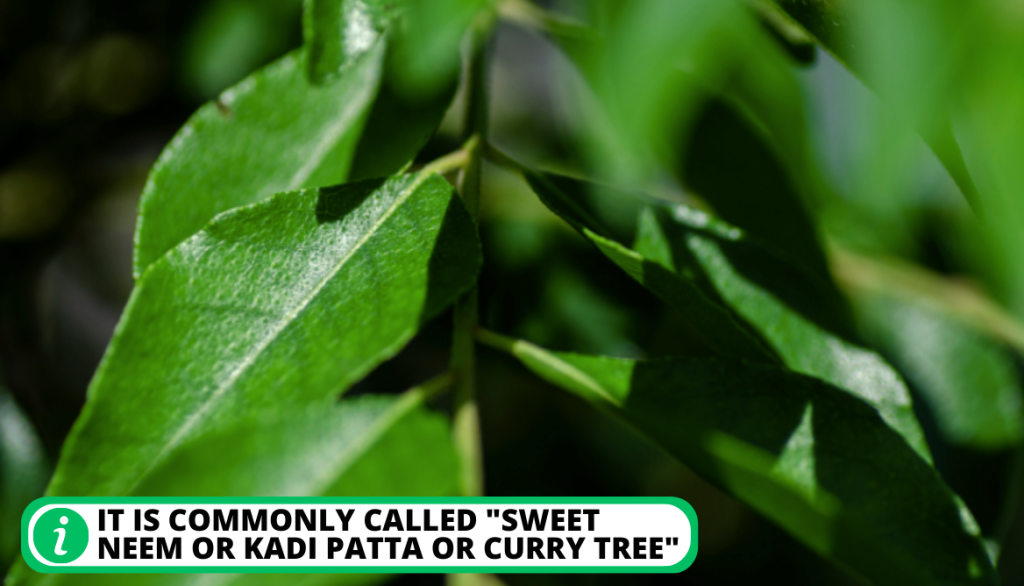
Curry Tree Crucial Details
The curry leaf plant has been used for generations now. Here is a detailed list of the specifications. Let’s learn more about it!
Common Name: | Curry tree, curry leaf tree, curry plant, sweet neem, meethi neem, kadhi patta |
Botanical Name: | Murraya koenigii |
Family: | Rutaceae |
Plant Type: | Tree |
Mature Size: | 6-20 ft. tall, 4-12 ft. wide |
Sun Exposure: | Full |
Soil Type: | Well-drained |
Acceptable pH: | Acidic |
Bloom Time: | Spring, summer, fall |
Flower Color: | White |
Hardiness Zones: | 9-12 (USDA) |
Native Area: | Asia |
Looking After the Curry Leaf Plant
Caring for the curry leaf plant can be a very tricky task during its growing phase as it is very sensitive to wind. The truck is weak and the branches are also thin at the start. But, as it grows it gains strength and becomes highly resistant to drought, high temperatures, and infertile soil.
In winter, the only to grow the curry leaf plant is in containers. You would need to let it stay outdoors in summer while sheltering it indoors during winter. Let’s shed light on some of the other factors that need to be taken care of!
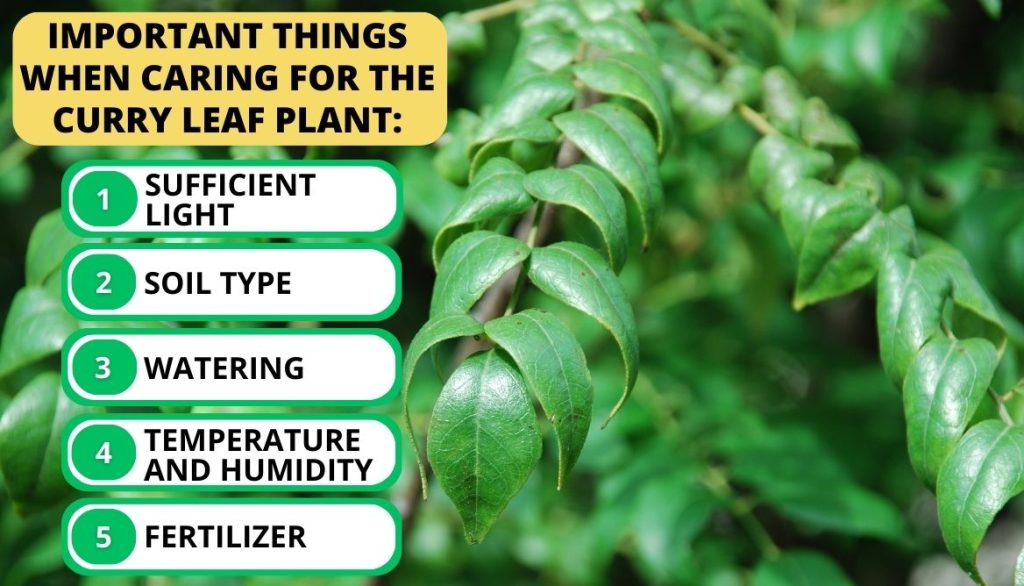
1. Light Needed By the Plants
The curry plant is not like other leaves that wither in full-on sunlight. Surprisingly, it grows excellently in the sunniest location of your garden. It produces more foilage in sunny conditions.
2. Soil for the Plants
The curry leaf plant requires well-drained and fertile soil having a pH between 5.6 – 6.0. Maintain the required acidity for the best results. When fully grown, the curry tree on the other hand needs dry soil.
3. Watering the Plants
Here is what you need to keep in mind when watering the curry leaf plant!
- You need to regularly water the curry leaves during the initial 2 months.
- Let it dry out after heavy rainfall or conditions such as deep watering.
- Once dried, you will need to water it in moderate quantity.
- Never water during the winter season if the tree is in dormant condition or when the temperature drops below 0 degrees.
- If you have potted curry plants then they would need frequent watering after 2-4 days. This depends on the size of the planter and climatic conditions.

4. Ideal Temperature and Humidity for the Plants
The tree and curry leaves are resistant to frost but that does not mean that it can withstand extreme winter all year around. It is a best practice to keep it above 40°F.
In very cold conditions, the tree will start to shed curry leaves and go into a dormant state until the start of the spring season. The ideal condition is hot and humid conditions.
5. Use Suitable Fertilizer for Plants
The curry leaf tree does not have a lot of fertilizer demands. Even DIY fertilizers can get the job done. Opt for wood ash or rice water on a weekly regular basis for the best results.
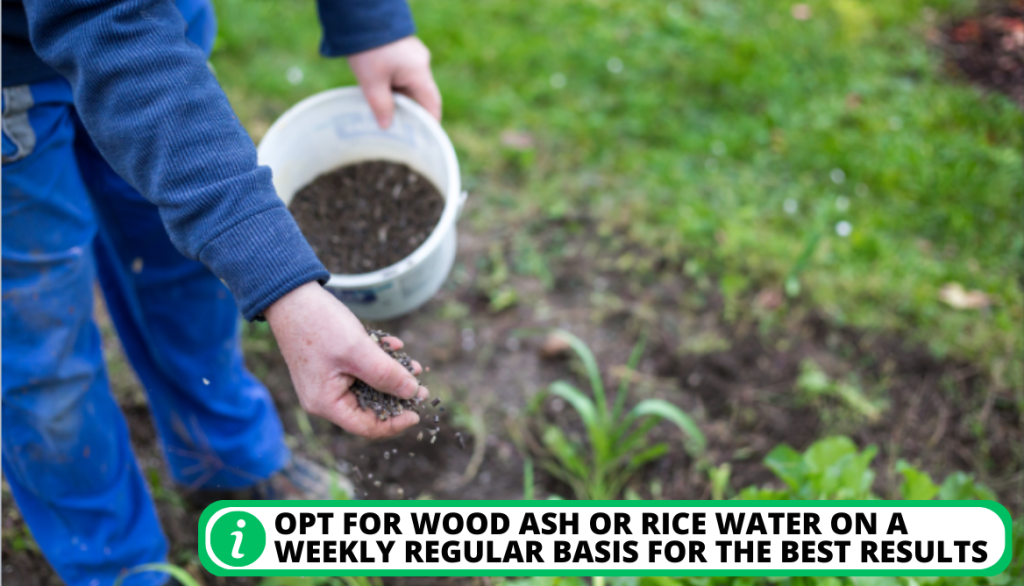
Growing Tips for Curry Plants
Some tips can make growing curry plants easier in the gardens or indoors. Here is what you need to do!
- Keep check of the moisture level in the soil and the condition of the curry leaves. The curry plant needs a well-drained area for healthy growth.
- During extreme sunny hours, some shade works like magic but otherwise, mature plants will stay healthy during full sun.
- Keep a check on the nutrients and pH level too. If needed then fertilize all around the year.
- Ensure that the watering is consistent but avoid over-saturating the soil as it is harmful to the plant.
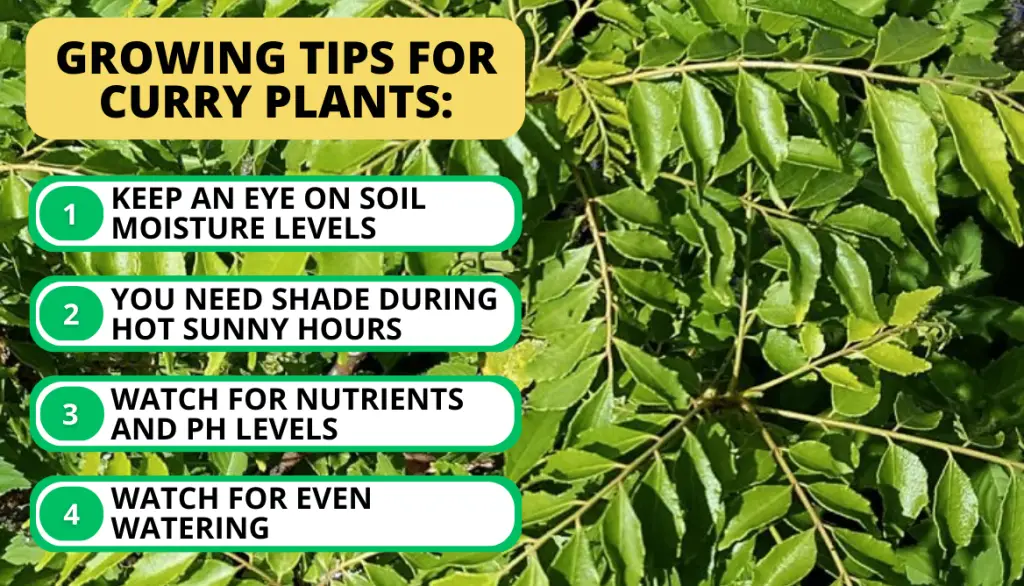
The DO’s and DONT’s
While growing the curry plant you need to be very cautious about the watering, soil type, and required sunlight. The plant and the tree have different needs at times.
The table below will help you to understand how to care during different phases. Let’s dive in:
Spring (40F to 85F) | Summer (85F and above) | Fall (Below 80F) | Winter (Below 40F) | |
Transplanting: | Do | Don't | Do if Needed | Don't |
Pruning: | Do | Don't | Do if Needed | Don't |
Fertilizing: | Do | Do | Don't | Don't |
Sunlight: | Full Sun | Partial Shade | Full Sun | Sunny Window/ Artificial light |
Watering: | Weekly | Every 2 to 4 days | Weekly | Every 3 to 4 weeks |
Watch Out For: | Scales | Spider Mites, Black Spots | Spider Mites, White Flies | Scales, Spider Mites, White Flies, Fungus Gnats |
The Positives of Growing Curry Leaf Plant Bunnings
If you want to beautify your garden then this is the best choice for your garden. The Curry does more than just add some greenery. Here are the amazing benefits:
- Cuisines: Curry leaves are a staple spice in Indian cuisines but are more than a flavor-adding ingredient. They add delicious flavoring to your food and help to enhance many different spices.
- Health Improvement: They help to prevent serious illnesses by boosting blood circulation and enhancing immunity levels. It is also excellent for people suffering from depression or in the early stages.
- Beauty Usage: It has outstanding results when applied to the skin or hair. A large number of people are using curry leaves as a hair conditioner. You can also add the curry leaves to the bath water to help avoid skin diseases.

Growing Curry Plants in a Planter
Growing a small plant in a potted indoor setting can be a tricky process. Let’s learn how to do it efficiently!
- Step 1: Select an ideal planter size (300mm deep and wide) and add a nutrient-rich potting mix. Now let the pot rest in a full sun or partial shade location.
- Step 2: Plant the seedling directly in the planter or use cuttings. ensure that there is more than enough space between the plants. You may also use a raising mix to evenly cover the seeds.
- Step 3: The seeds need to be watered regularly but after germination, they only need to be watered once a day. Also, thin them out and if needed then use a liquid plant food for better growth results.
- Step 4: The small plant also grows sufficient foliage around the year and their leaves can be harvested when they reach the right size. The growth of curry leaves slows down during winter. An advantage is that the leaves can be dried out for use later.
- Step 5: Always check on the new growth routine of the herb. You need to maintain the plant during the late autumn and winter season for the best growth results in the spring.
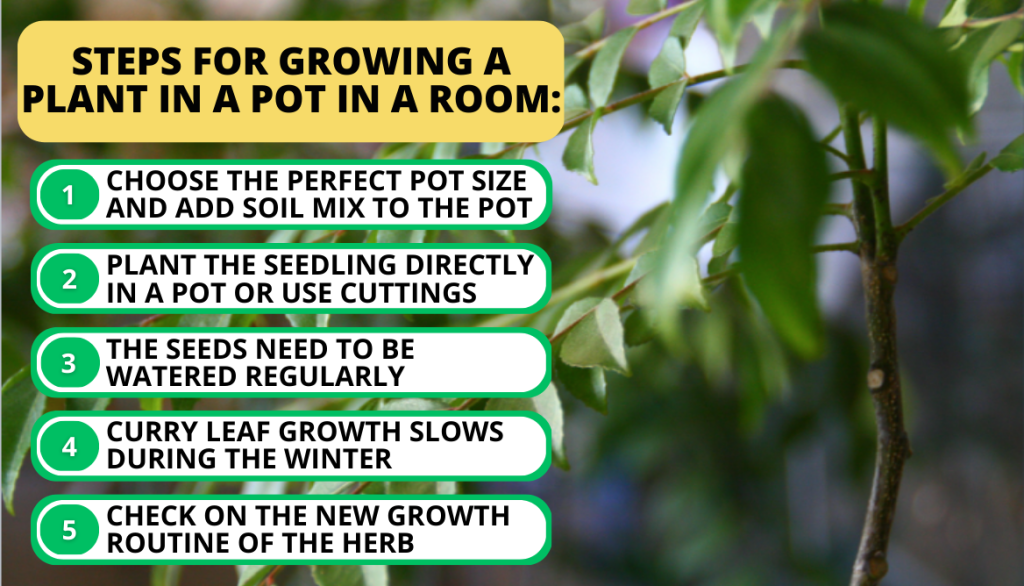
How to Tackle Pests and Diseases
Like all other vegetation, the plant is also the target of some pests and diseases. These can be avoided with the proper care and administration of pesticides. Let’s find out how we can avoid unwanted invaders!
Pests on Curry Leaves
The most common pests to attack the plant are aphids which stick to it and suck on the juices. Some amazing tricks to battle these pests are:
- Spraying them down with cold water.
- Dusting them with flour.
- Applying neem oil to protect the root and stem.
Other pests that may attack are spider mites that may form small webs and start to feed on the curry leaves.
Curry Leaves and Diseases
A common disease in curry plants is a “leaf spot” caused by bacteria and fungi. This disease weakens the plant and if not treated it will exterminate it completely.
Another disease is citrus greening caused but the bacteria Candidatus Liberibacter asiaticus.
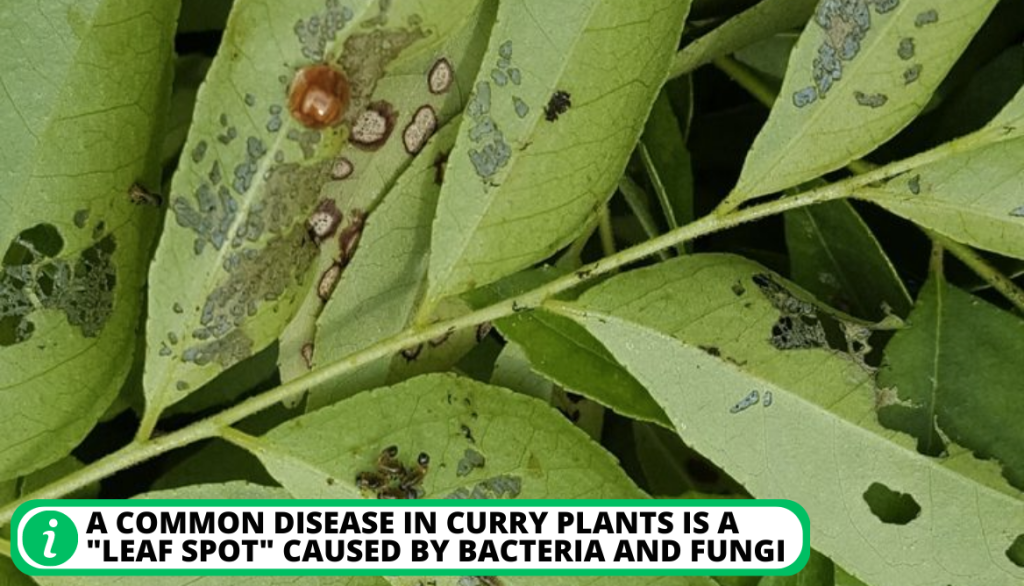
Harvesting the Plant
It is not a very complicated task. Here is a complete guide on how to do it. There are two ways to do it!
Method 1
Here is how you do it!
- Pluck the curry leaves if you need them.
- Or, can leave it to grow and then yield a larger harvest of two to three times per year.
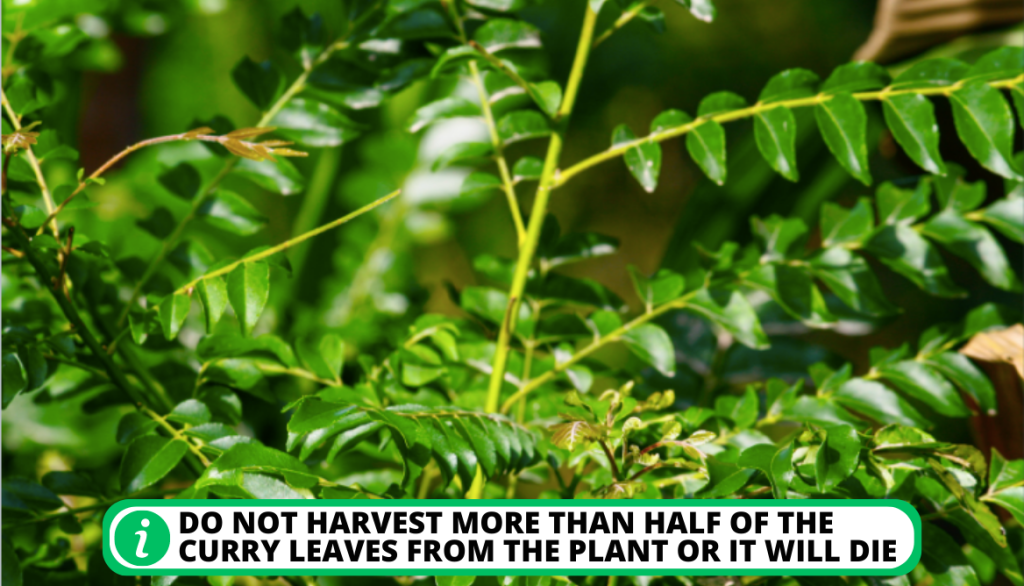
Method 2
Check out another method to do it!
- Cut down the branches after every two months during the growth cycle.
- Use scissors or pruners to do this.
- Make sure to leave some inches at the base of the branch.
FAQ
What are curry leaf plant Bunnings?
Curry leaf plant bunnings are native plants that originate from South Asia, especially Sri Lanka, and India. They have a strong fragrance and are used in different cuisines.
Is a curry leaf tree poisonous?
Curry leaf tree is not poisonous. They have various health benefits and are edible.
Can you grow a curry tree in a container?
Yes! You can grow the curry tree in a container indoors during the early stages of growth.
Why are my Curry trees drooping?
The curry trees drop as there may be very less water and the soil is dry. This results in a lack of nutrients in the plant as it is unable to transfer them to its different parts.
How do you grow curry leaves from cuttings?
Growing curry leaves from cuttings is easy! Take a sharp prune or knife, now cut a three-inch part from steam with some leaves. Take off the curry leaves from the bottom part of the branch. Fill a 4-inch deep planter with soil and plant it in it.
How long does it take for the curry leaf to grow?
Curry leaves grow to full maturity in 1-2 years.
Conclusion
Curry Leaf Plant is a versatile and valuable addition to any home garden or kitchen. With its fragrant leaves and unique flavor, it has become an essential ingredient in many traditional dishes. It is easy to grow and care for, making it an ideal choice for novice gardeners or those with limited space.
Did you have the curry leaf plant in a pot or on your lawn? Let us know in the comments section!
- How to Get Potatoes to Sprout Eyes: Detailed Growing Guide with 3 Options - July 31, 2023
- Weight of a Medium Potato: Revealed in Detailed Guide - July 29, 2023
- Maris Piper Potatoes: 9 Substitutes You Should Know About - July 27, 2023
Hello! I’m Jessica Zander, a garden coach and consultant based in the Boston area (zone 6b), offering virtual consultations across the country and Canada.
I’ve been passionate about gardening since the early 1990s, and in 2022, I launched You Can Do It Gardening to empower individuals to feel more confident in their gardening endeavors.
Following a 30-year career in nonprofit finance and operations, I transitioned out of that field in mid-June of 2023 due to the growing demand for coaching services. Interestingly, my years of presenting financial statements to boards and finance committees proved to be valuable experience for teaching people about gardening! I enjoy sharing skills, providing guidance and suggestions, and collaborating efficiently with clients to make significant improvements to their outdoor spaces, both small and large. I also regularly teach at the Arlington Continuing Education and Cambridge Adult Education.
My approach is direct and practical, akin to Mary Poppins, but tailored to your garden. Clients find satisfaction in saving money and taking pride in their own gardening achievements.

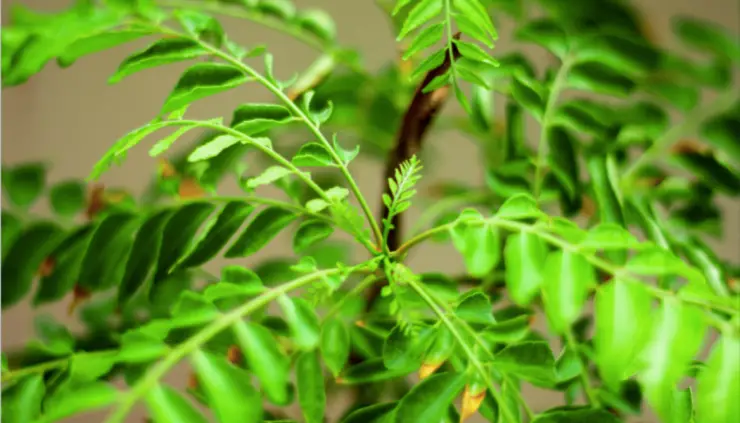

Add comment